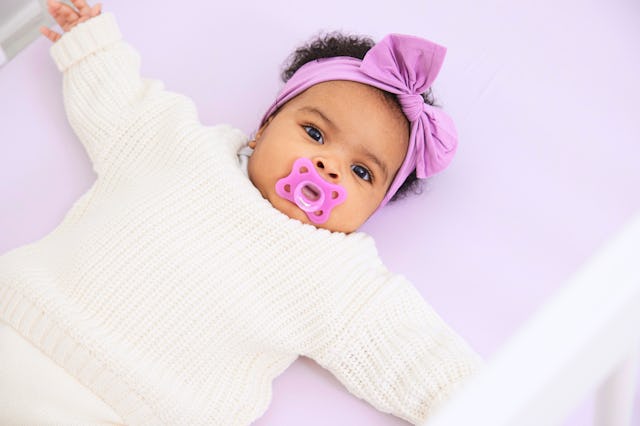Pediatric Dentists, Lactation Consultants, & Moms Are Loving These Smartly Designed Pacifiers
And lots of them are cute, too.

Pacis. Binkies. Dummies. Bobos. Whatever you call them, pacifiers can be a big part of babyhood. But new and expecting parents often have lots of questions about them. Like, when do you introduce a pacifier? Will they interfere with breastfeeding? What about thumb sucking, instead? And the big one: which pacifier is the right pacifier?
To the last Q, we recommend MAM pacifiers (like the MAM Comfort Pacifiers and MAM Original Night Pacifiers), which are developed alongside medical experts. All MAM Pacifiers have curved shields that sit comfortably on baby’s face and leave plenty of space around the nose, air holes in the shield to allow baby’s skin to breathe, and symmetrical soft nipples. MAM pacifiers are made with baby’s oral development in mind and come in a variety of styles and sizes to evolve with growing babies' needs.
For all of those other questions that come up during your search for the right pacifier for your baby, we got in touch with Dr. Jeremy Dixon, a pediatric dentist, to help us out.
Dr. Dixon told us that pacifiers have been shown to reduce the risk of SIDS (sudden infant death syndrome), and that he recommends introducing them after your baby has gotten into a good feeding routine — usually no later than a month old. “Gently stimulate the lower lip and tip of the tongue and wait for the suckling reflex,” she said. “It doesn’t always happen on the first try, so make it a game so your baby will be excited to give it a go!”
When we asked him to weigh in on the age old debate — that is, pacifier vs. thumb sucking — he had a clear stance. “Babies are born with a sucking reflex,” he said, and both thumb sucking and pacifier use can calm them and reduce stress. But she says it’s best to stop these habits before age 4 to reduce the possibility of orthodontic tooth changes. “This weaning process is generally easier with a pacifier for the simple fact that the pacifier is not attached to the body, like the thumb. Parents have much more control over these habits with a pacifier.”
Finally, what pacifier does he tell parents to use? “Look for one made of high-quality silicone with a guard diameter of at least 1.5 inches,” she said, and explained that pacifiers with a slim nipple profile can reduce the possibility of orthodontic tooth changes as your baby gets older. “I love MAM pacifiers because they were developed with dentists. A lot of other pacifiers can cause dental problems that I see in young patients, so MAM is the way to go.”
To get some answers about pacifiers and breastfeeding, we talked to Sarah Peck, a Registered Nurse and lactation consultant. When asked about the myth that pacifiers interfere with breastfeeding, she offered that the evidence on pacifier use inhibiting breastfeeding is not, in her opinion, strong enough to discourage the use of a pacifier in a newborn. “If a pacifier is needed and helpful — I recommend using it,” she said.
She even told us that pacifiers can ease stomach discomfort and aid digestion, and can actually help infants learn to breastfeed. “I personally use pacifiers to suck train an infant and encourage a latch during breastfeeding initiation,” she said. And for breastfeeding parents, Peck recommends using a pacifier “with a rounded shape without a slanted tip, so that the tongue posture mimics that which is required at the breast. MAM pacifiers have this rounded shape, allowing an infant to go back and forth from pacifier to breast with ease.”
Whether you call them pacis, bobos, or some other as-yet-uninvented phrase that’s entirely unique to your family, pacifiers can be a big benefit in your child’s first few years. Trust the experts (and us…but mostly the experts) and add MAM Comfort Pacifiers and MAM Original Night Pacifiers to your cart or registry.
MAM pacifiers are available at Amazon, Walmart, Target, and major drugstores and grocery stores nationwide.
Shop MAM Pacifiers